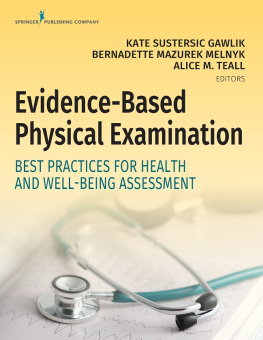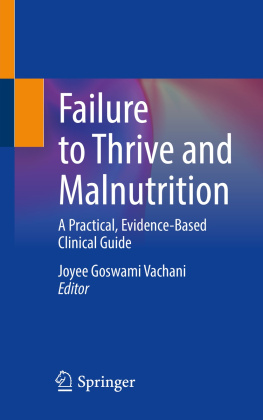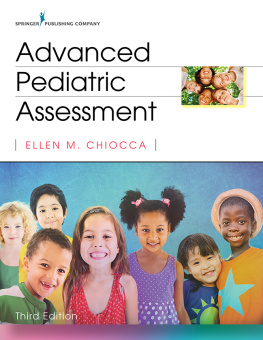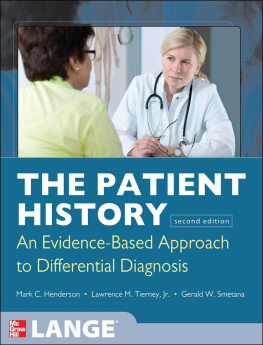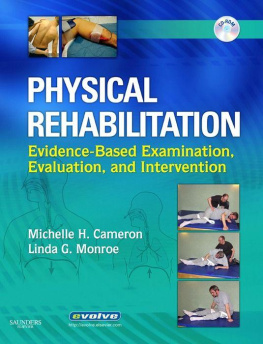xxxi Acknowledgments
Thank you to the authors from across disciplines and across the country who contributed to writing the chapters in this text. Your expertise in health and wellness assessments and insight into the evidence-based foundation of clinical practice will guide future health science students.
Thank you to colleagues who have truly been the wind beneath our wings. Thank you, Kathy York, for your support, which spans a decade. Thank you to Rosie Zeno, whose pediatric expertise and dedication to this project involved significant contributions to four chapters and whose support in helping us to meet deadlines will be long remembered.
Thanks to all of you who were willing to be a part of the photos and videos associated with this effort, including family, friends, and colleagues who either collaborated to create patient cases or contributed normal and abnormal findings so that others may learn. Special thanks to Mallory Caldwell; your willingness to be a part of this effort is greatly appreciated. Thank you to Jason, Amy, Nathan, Matt, Andrew, Maya, and Portia; your contributions are seen within the pages of this text.
Without the support from our team at Springer Publishing Company, this book would not exist. Thank you for this rewarding opportunity. Adrianne Brigido, your feedback has been invaluable. We are grateful for your work in bringing this text to publication. We are also grateful for the efforts of Robert Pancotti, Senior Content Development Specialist.
To all of the health science students whom we have had the opportunity to teach, thank you for demonstrating a willingness to learn and for your dedication to providing the best, evidence-based, patient-centered care for individuals, families, communities, and populations. You make us proud. We see you as clinicians who focus your clinical practice on partnering with individuals in a way that improves their health and wellness. You are changing the culture of the healthcare delivery system. xxxii
1
Approach to Evidence-Based Assessment of Health and Well-Being
Kate Gawlik, Bernadette Mazurek Melnyk, and Alice M. Teall
Health is a state of complete physical, mental and social well-being and not merely the absence of disease or infirmity.
WORLD HEALTH ORGANIZATION
LEARNING OBJECTIVES
Describe the rationale for an evidence-based approach to the assessment of health and well-being.
Apply the principles and steps of evidence-based practice that guide assessment of the dimensions of wellness.
Identify evidence-based resources to guide health assessment strategies, approaches, and techniques.
SYSTEMATIC APPROACH TO ADVANCED HEALTH AND WELL-BEING ASSESSMENT
Assessment is the action of making an appraisal, judgment, or evaluation. Advanced skills of assessment include an interpretation of findings within the complexity of a situation. To effectively implement advanced assessment skills in clinical practice involves a complex series of steps; a foundation of knowledge; an ability to appreciate the information shared by an individual, patient, or family; and clinical interpretation of the assessments of health and well-being.
Advanced assessment is the cornerstone of clinical practice. Clinicians use advanced assessment skills as the foundation for delivering quality care. To deliver the highest quality of healthcare and ensure the best patient outcomes, there has been a dramatic shift in clinical practice to incorporating the latest research or best evidence and to questioning the processes and systems that have been in place for years to determine whether they are the most effective and efficient methods. Evidence-based practice (EBP) is a lifelong problem-solving approach to the delivery of care that incorporates the current best evidence with a clinicians expertise and patient or family preferences and values (). However, even with all of its positive benefits, EBP is not the standard of care in many healthcare systems owing to multiple barriers, including inadequate EBP skills in clinicians and cultures, which promote a philosophy of that is the way we do it here.
If assessments are not thorough or findings are not interpreted within the context of the best clinical evidence, errors are more likely. Findings from research indicate that approximately 400,000 people die every year from preventable medical errors, and this is now a public health epidemic and the third leading cause of death in the United States (). Although numerous factors influence the occurrence of errors, using the best evidence in clinical assessment and management has been identified as a priority in reducing the number of preventable medical errors and improving population health outcomes. While there has been steady progress in the evidence-based management of clinical problems or diseases over the past 2 decades, incorporating the best evidence in health and well-being assessment has been much slower. Specifically, a number of commonly taught physical assessment techniques have demonstrated a low sensitivity, a low specificity, and negative predictive value (e.g., scoliosis screening), and yet these techniques continue to be incorporated when teaching clinicians assessment skills. Unfortunately, many well-meaning clinicians across the United States are steeped in a practice rooted in the way they were taught years before or are following outdated practices and policies not based on the best evidence. As a result, the quality, safety, and health outcomes of their patients are not as optimal as they could be if these clinicians were consistently steeped in EBP.
This book takes a new approach to the process of advanced health and well-being assessment through rigorous critical appraisal of the evidence underlying history and physical exam techniques, assessment strategies, the use of imaging tests or lab studies, and/or approaches to health and well-being. Evidence-based assessment lays the foundation for building comprehensive differential diagnoses or a problem list, provides the strategies for triaging the acuity of the patient, and creates the groundwork for integration of wellness, health promotion, and disease prevention into the plan of care based on the best and latest evidence. Thorough history-taking and assessment provide the clinician with key subjective information and tangible, objective information on which to base current and future decision-making. Only with comprehensive, accurate, and evidence-based assessment can a clinician ensure patient safety, quality, and cost-effective care.
THE IMPORTANCE OF EVIDENCE-BASED ASSESSMENT
Kaylins Story
Kaylin was 8 years old when she went to New Zealand and Australia with her parents for a dream trip. The trips first layover was at the Los Angeles airport, where Kaylin enjoyed dinner and an ice-cream sundae. She was the picture of health when leaving Los Angeles and was very excited to be going to the land of koala bears. However, approximately 3 hours from New Zealand, Kaylin awakened her mom, who is a pediatric nurse practitioner, from a deep sleep to let her know that she was feeling sick, specifically saying that her belly hurt. Her mom felt her forehead, which revealed she had a fever. Then, within an hour, Kaylin started vomiting, and her mom suspected early appendicitis. The pattern of fever and abdominal pain that preceded vomiting was the classic picture of appendicitis. Kaylins mom woke her dad to let him know that Kaylin was sick and that she suspected early appendicitis. Kaylins dad was convinced that this was the gastrointestinal (GI) bug that he had experienced 4 days earlier.
Kaylin continued to vomit intermittently for the rest of the flight to New Zealand. After landing, Kaylins parents took her immediately to a 24-hour medical facility, where they conveyed concerns about early appendicitis to the physician who evaluated her. After examining her and running a few lab tests, it was decided that she just had a GI virus and that she could be taken to her hotel. The physician kept emphasizing that Kaylin did not have abdominal rebound, which is a common physical assessment sign of appendicitis.
Next page
